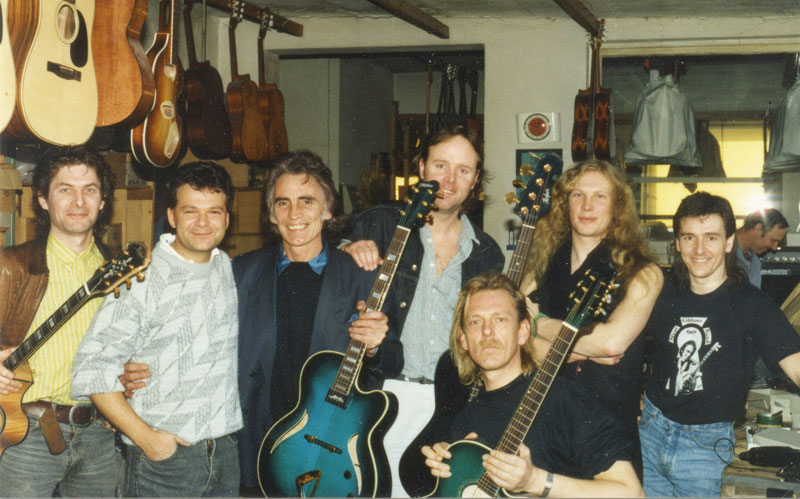

Klaus Schӧller (2nd from left) with the Steve Gibbons Band during their visit to the Bubenreuth workshops in March 1989.
Yes, the A2L and A2HL models were advanced guitars -
they were full of active circuitry. However, the Hӧfner traditional
craftsmanship and attractive design style were also very apparent in both. A new
archtop guitar with that same Hӧfner woodworking flair, but with simple passive
electrics made its debut in 1981…this being Hӧfner’s second endorsee
guitar....
Attila Zoller was a world-famous jazz guitarist, born in Hungary, who by the time that he had arrived in Germany in 1953 was well on his way to becoming a legend. In 1958, he had teamed up with the Framus Company who were Hӧfner’s main competitor in Bubenreuth, and had helped design and endorse the Framus Attila Zoller model. This association was successful for both Zoller and Framus, with the result that other guitars bearing his name were produced right up to the time of Framus’ demise into bankruptcy at the end of the 1970’s. The Framus AZ-10 was probably the most well-known and most highly acclaimed model, and this was made right up to around 1979.
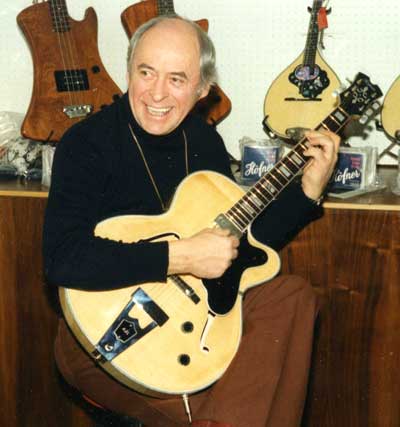
Perhaps it was inevitable that Attila should
appear on the Hӧfner stand at the Frankfurt Show of 1980, despite the fact that
he now lived in the United States. He was photographed whilst sampling a Hӧfner
A2L archtop, looking very happy indeed with what was Hӧfner’s top archtop at
that time. Events then appear to have dropped into place very quickly, and by
mid-1981 the first Hӧfner AZ Award had been completed, followed by a further
three before the end of the year. By March 1982, the Award version had been
joined by the AZ Standard and these two models were produced in tandem up to
1989.
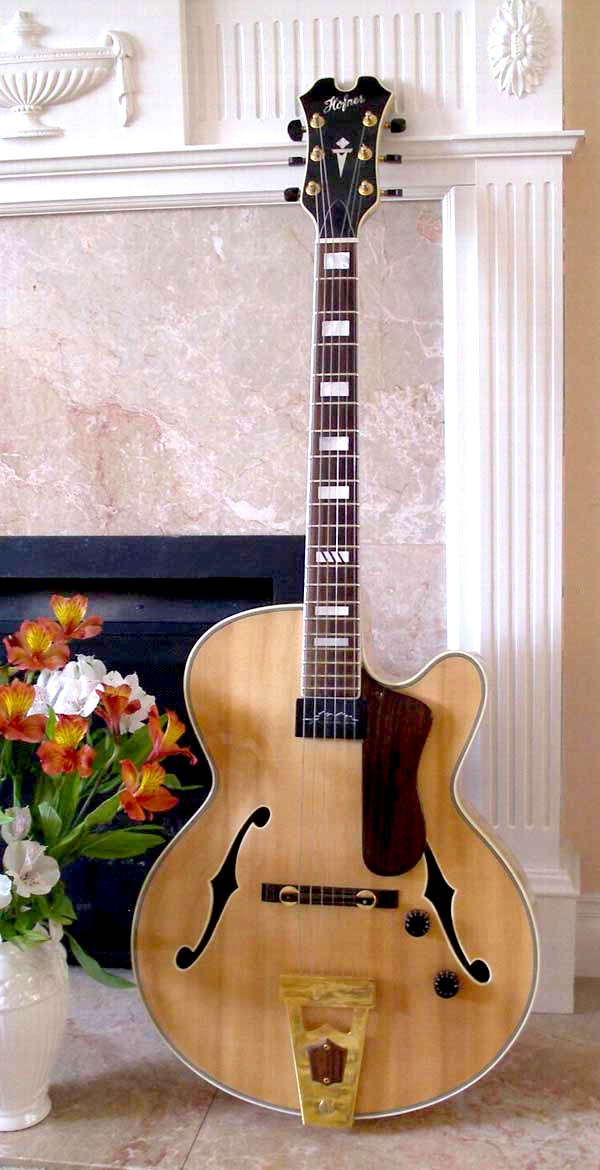
Hӧfner AZ Award |
The two AZ versions were
mid-size 16¼” wide body archtops, with carved solid spruce tables and
laminated flame maple back and rims. A single floating “bi-directional”
pickup designed by Attila himself was fitted to the end of the
fingerboard, with single volume and tone rotary controls mounted
directly onto the table conventionally on the lower bout just below the
F-hole. This pickup was manufactured by the Shadow Company, who
designated it as the “AZ-48 Jazz” pickup.
The body profile itself departed somewhat from
the easily recognisable traditional Hӧfner shape, in that the cutaway
had a tighter radius to that on other Hofners and hence appears to be
more pronounced. The necks were single piece maple capped with a
rosewood fingerboard in which were inlayed mother of pearl block
markers, ornamented by the incorporation of cross cuts. The headstock
itself was large with a very impressively notch-shaped tope edge, and
fitted with Schaller tuners. The headstock fascia comprised of bound
holly wood, but inlaid with a discreet Hӧfner “dagger” mother of pearl
inlay. A rather dramatic “Zoller” signature inlay was used for the
headstock logo rather than “Hӧfner”. The package was completed by a carved rosewood
pickguard and ebony bridge, with a modified version of the adjustable
string-tension tailpiece used on the Hӧfner A2L. This had a motif on it
describing which version of AZ the guitar was. |
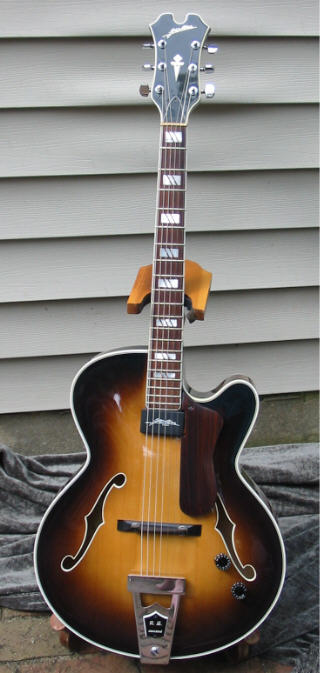 Hӧfner AZ Standard |
The AZ Award was provided with a blonde
“natural” finish, and had gold plated fittings. The AZ Standard had a
dark brown sunburst finish, with chrome plated fittings. How much input
Mr Zoller put into the design of his signature guitar is not known, but
certainly this guitar showed a significant step-up from the A2L with a
carved solid top rather than the A2L’s laminated spruce, the AZ-48
pickup rather than the Schaller-made humbucker, and the rather nice
ornamental touches such as the rosewood pickguard.
Some of the AZ guitars went to Attila’s personal pupils
at his Vermont Jazz Centre, as well as being actively used by himself of course.
Another major user of the Hӧfner AZ was Jimmy Raney, who together with Attila
visited the Hӧfner workshops at Bubenreuth in May 1982, just at a time when Hӧfner
were nicely settled in to making the AZ guitars. A photographer was on hand to
record this visit, and Attila and Jimmy were photographed checking some of the
guitars being made on the workbench, and also playing the finished products. The
owners of the Hӧfner Company, Christian and Gerhilde Benker, are shown looking
on, together with Gela Hildebrand who was still Hӧfner’s design consultant at
that time and who almost certainly had more than a passing input into the design
of these prestigious instruments.
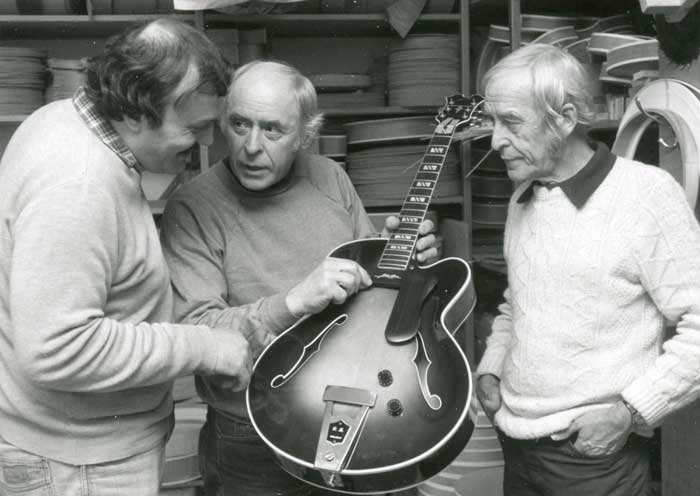
Interpreting what remains of Hӧfner’s own company
shipping records is a dubious process, but it would appear that between 1981 and
1991, a total of at least 46 Awards, and 34 Standard models were shipped from
Bubenreuth to destinations other than Attila and his pupils in the US. The
indications are therefore that somewhat less than 100 of these fine guitars were
made in total. There were a few special orders made of course, including one or
two left-handed guitars and at least two acoustic guitars, without electrics
fitted.
In 1988, Hӧfner introduced
the AZ Collection. Sales of the AZ had not met anything like Hӧfner’s initial
expectations, and maybe this model was intended to boost sales. The AZ
Collection was basically an Award with a very attractive Bordeaux Red finish in
place of the usual blonde. Together with gold plated hardware, (although there
is at least one Collection out there fitted with chrome), this led to a stunning
looking guitar. A very similar finish had been successfully applied in the
previous year to certain limited edition Hӧfner guitars, including the
semi-acoustic Nightingale model, in order to mark Hӧfner’s 100th
Year Anniversary. Very few “Collection” guitars appear to have been produced,
and there is very little documentation regarding them within Hӧfner’s remaining
archives.
c1990 Hӧfner AZ Special, fitted with a replacement Bartolini in place of the original Zoller pickup.
The AZ Special appeared as a
replacement for the AZ Standard in early 1989. This was actually just a slightly
dumbed-down AZ Standard, with a cheaper “Lyre” tailpiece. Although Hӧfner
weren’t selling many AZ guitars, they seem to have taken a rather strange step
with regard to pricing policy in 1989 as they actually increased the retail
price of the AZ Special to a level almost as much as that being asked for the AZ
Award and Collection guitars the year before! The following table demonstrates
this policy, and also provides price details of the AZ Fusion which is dealt
with later in this chapter:
|
|
Retail List Price in Deutschmarks |
||||||||
|
Feb 1982 |
Jan 1984 |
Feb 1985 |
Feb 1986 |
Feb 1987 |
May 1988 |
Jan 1989 |
Mar 1990 |
Mar 1991 |
|
|
AZ Standard |
2740 |
2740 |
2850 |
3020 |
3107 |
3107 |
|
|
|
|
AZ Award |
3100 |
3100 |
3232 |
3410 |
3510 |
3510 |
3,840 |
3,990 |
4190 |
|
AZ Collection |
|
|
|
|
|
3618 |
|
|
|
|
AZ Special |
|
|
|
|
|
|
3,400 |
3,540 |
3,720 |
|
|
|
|
|
|
|
|
|
|
|
|
AZ Fusion |
|
|
|
|
|
|
2,400 |
2520 |
2,640 |
|
AZ Fusion Midi |
|
|
|
|
|
|
2,640 |
2800 |
2920 |
At around this time, Hӧfner dropped the “Zoller” logo
from the headstock and replaced it with “Hӧfner”. Why they did this is difficult
to ascertain, but it may have been related to a cooling of relations between Hӧfner’s
management and Attila himself. Also, further cosmetic options were introduced
including a black finish option for the Special and black chrome being available
for the hardware as an option to gold-plating on the Award. By that stage
regimented specifications for the various models seemed to have broken down as
Hӧfner attempted to clear what remained.
The AZ archtops were dropped from the price lists at the
end of 1991, although one or two of the last that had been lingering around the
workshops were shipped out in 1992 and 1993.
As explained above, Gela Hildebrand was the Hӧfner
design manager who liaised with Attila Zoller in the early 1980’s in order to
produce the fine signature archtops described above. By 1984 however, Hӧfner had
to look for another product manager, and they were able to fill this now vacant
post with a guitarist/luthier by the name of Klaus Schӧller. Klaus had had a
varied career up to that point, having been a guitar magazine editor before
ending up owning and publishing his own magazine. He then returned to being a
student, travelled all over the Americas, and finally began his professional
guitar design work by producing a guitar construction kit for the tone-wood
company Kollitz. It was Fritz Kollitz who actually recommended Klaus to
Christian Benker, and so he found himself signed up to the Hӧfner Company
initially on a freelance basis.
Klaus’s first commission was the design of a solid
guitar to replace Hildebrand’s “S” series solids. The amazing looking Hӧfner
Alpha solid guitar was the result, closely followed by the more traditional
looking Hӧfner “Reference” range of solids. By 1986, Klaus had also designed a
good quality but more traditional looking semi-acoustic guitar with the
obligatory twin body cutaways called the Nightingale, which will be described
later in this chapter.
Hӧfner were well please with these individualistic
high-quality designs, and in 1989, Klaus took up the permanent position of Hӧfner’s
Product Manager for electric guitars.
As with the appearance of most “new brooms”, interesting
things seem to occur when a dynamic product manager is brought into a company.
This may well have accounted for the appearance of the AZ Fusion guitars in Hӧfner’s
product range of 1989. What is more likely however is that Klaus probably found
himself with a pile of AZ archtop components in the workshop that was the result
of lower than anticipated orders for these very fine but expensive instruments.
They had to be built up into guitars that could be sold at a much cheaper price
than the signature archtops and to a much bigger market than that for high-end
jazz guitars. Klaus already had his Nightingale under production and selling
moderately well, but the need to use up the AZ gear prevailed and this resulted
in the AZ Fusion guitars.
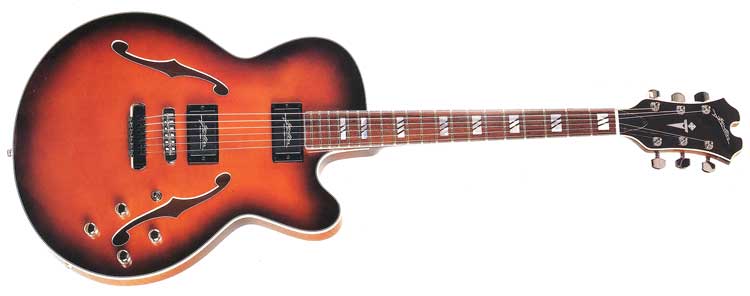
The Fusion was given a single cutaway body to the same
plan dimensions as the AZ archtop, but with a depth of 48mm. However, the body
top was made using pressed laminated spruce and a solid spruce sustain block was
incorporated making the guitar a true semi-acoustic. The back and rims were
laminated flame maple as used for the archtop models. The neck and rosewood
fingerboard were as fitted to the AZ Special archtop. A stop-tailpiece was used
however, taking advantage of the sustain block.
The same Shadow-made Attila Zoller Z 48 pickups as used
on the archtops as a neck floating pickup were mounted within a conventional
frame directly onto the body top in both the neck and bridge locations, and
these were controlled by conventional passive four-rotary controls and one
three-way selector switch. As a gesture to Hӧfner’s love-affair with electronic
gizmos, a midi version was also available and this was fitted with a Shadow 1500
MU midi-pickup at the neck, together with in-built synthesiser.
Both versions were available as the archtops with
Bordeaux Red, Antique Brown sunburst, and solid Black finishes, together with
chrome, black chrome, or gold-plated hardware.
As can be seen from the retail price table above, the
Fusion semis were offered for about 2/3rds the price of the AZ archtops, which
bearing in mind the extra electrics on the Fusions was a very sizeable
reduction. That was really immaterial however – the Fusions were aimed at a
totally different market and unfortunately they were still around 10% more than
the price of a Nightingale Standard. The Fusion doesn’t seem to have sold well
at all. In fact, examples are extremely rare and may not amount to much more
than “prototype level”. Only five examples can be found recorded in Hӧfner’s
shipping records for the period between 1989 and 1994.
Klaus Schӧller designed the Nightingale model in 1985
and two prototypes did actually appear at Frankfurt in February 1985. The
production Nightingale was however launched properly at the 1986 Frankfurt Trade
Fair, with Golden Sunburst and Solid Black finish examples on show
This new model was a twin cutaway semi-acoustic guitar
with a sustain block inside the body. The shape of the body moved away from the
traditional “Verithin/4574” style in so far as the cutaway horns were much more
pronounced and the lower bout shape appears to be more bulbous than the usual Hӧfner
body - one has to say very similar indeed to the Gibson ES3xx shape. The body
timbers were composed entirely of laminated figured maple, with the neck being
carved from a single piece of hard rock maple.
At first glance, the electrics
appeared to be conventional with the usual four rotary pots and a three-way
selector switch. A Schaller-made “Gold 50” humbucker was fitted at the neck
position. However, what wasn’t so evident was that the guitar was actually
fitted with “Clear Contour Control” tone pots for a Schaller-made split-coil
humbucking pickup at the bridge. This acted as a normal control up to about #8
on the control knob. Above that, one of the pickup coils was cut out with a
resulting single-coil sound being produced. Because the pickup still retained
its hum-cancelling properties at #10 setting, the single coil sound remained
hum-less, hence the “Clear” description.
In addition, the guitar provided either a mono
or stereo output dependent on the use of its two output jacks.
Other features of this first version of the Nightingale
were the micro-tuners on the Schaller-made tailpiece, the large mother of pearl
block markers set into a rosewood fingerboard, and a “Double Diamond” headstock
inlay design.
Hӧfner had adopted a new sales policy for their three brand-new models, the Alpha Solid, the Reference Solid, and the Nightingale in 1986. This was basically an ordering system whereby the prospective owner of the guitar was presented with a form by the retailer at the time of ordering, on which there was a detailed tick-list for the many options available for that particular model. After this had been filled in, the form was sent by the retailer back to Hӧfner who then built an individual guitar on the basis of the customer’s requirements. Presumably the idea was to allow the purchaser the luxury of having his own personalised guitar custom-made, but without any suggestion of inflated costs associated with similar "custom-shop” services offered by other manufacturers. Examples of the options initially available for the Nightingale included a Kahler “Stud Mount 2200” vibrato unit and block or offset dot fingerboard fret markers, together with accessories such as shaped cases and protection bags, and stereo leads. This option list was subsequently extended to cover hardware plating types and guitar finishes, plus several different types and combinations of pickups, including Hӧfner/Schaller, Seymour Duncan, Bartolini, and OBL.
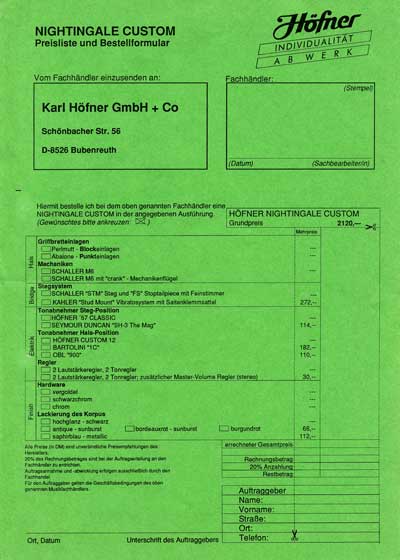
Special Order Form for the
Hӧfner Nightingale
The year 1987 brought along
Hӧfner’s 100th
Year Anniversary, and in order to celebrate this, three models - the Alpha
Solid, the Reference Solid, and the Nightingale - were made available for order
as “Anniversary” models. These limited edition guitars were finished in a
special “Anniversary Red Sunburst” finish and kitted out in gold-plated hardware
of course. Other additions to the already generous features of the “standard”
guitars included a master volume control and Schaller M6-mini crank tuners.
Hӧfner’s custom ordering system as described above for
the Nightingale appears to have been sub-vented somewhat by the introduction of
a Nightingale “Custom” model in 1988. This guitar offered the following
additional options included as a package to the standard Nightingale:
Schaller M6 Crank tuner
Kahler vibrato system
Seymour Duncan SH-3
pickup at the neck and a Bartolini “1C” or OBL “900” pickup at the bridge.
Master Volume
Chrome or Black Chrome
hardware
The option of Bordeaux
Red sunburst, antique sunburst, sapphire blue metallic, or burgundy finishes in
place of the standard guitar’s solid black finish.
Hӧfner were obviously struggling to educate the guitar
buying public to their personalised ordering system!
However, the “Custom” didn’t last very long, as in 1990
Hӧfner replaced it with the Nightingale “Special”. This version really was
special, with beautiful birds-eye maple used for the body, gold plated hardware,
and a black 24-fret ebony fingerboard in place of the 22 frets of the earlier
Nightingales. Other than the change in body laminates used, the
Special used the same master volume/Clear Contour electrics set-up as the
Custom. Those body timbers were shown off to perfection by the “antique gold”
finish. It certainly looked the business, and sales would appear to have
responded accordingly.
The “Special” and the “Standard” settled down to quite a
long production run – right up to the discontinuation of the Nightingale range
due to it being superseded in 2000 by the Verythin Classic.
__________________________________________________
All Text is Copyright
© 2022 Steve Russell. All Rights Reserved